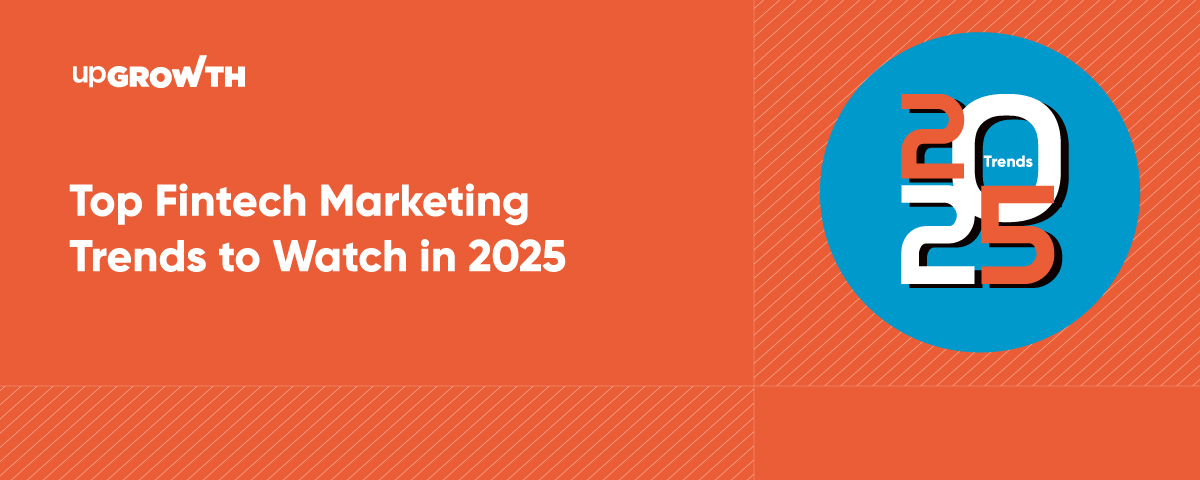Top Fintech Marketing Trends to Watch in 2025
Contributors:
Kiran Gurung
Published: December 5, 2024

Summary
The FinTech marketing landscape is undergoing significant transformation, with 71% of customers expecting personalized experiences and 83% discovering new products through social media. From advanced data analytics and AR implementations to gamification strategies and educational campaigns, companies are adopting innovative approaches to engage customers and build trust. These emerging trends, coupled with the growing emphasis on financial literacy and compliance, are reshaping how FinTech companies connect with their audiences while driving sustainable growth in an increasingly digital marketplace.
As the fintech industry evolves, staying ahead of the curve in marketing strategies is essential for success. In 2025, several key trends are set to reshape how fintech companies engage with their audiences. Moreover, you can optimise your campaigns for maximum impact by staying updated with the latest fintech marketing trends and industry insights.
This blog explores these trends, focusing on integrating innovative marketing techniques, including Google Ads best practices.
Why is Fintech Marketing Important?
- Differentiate Your Brand: Stand out from the crowd and showcase what sets your Fintech Marketing strategy apart.
- Attract New Customers: Reach your target audience and generate leads with targeted marketing campaigns.
- Retain Loyal Customers: Build strong customer relationships through personalised experiences and valuable content.
- Enhance Brand Visibility: Increase brand awareness and recognition through consistent marketing strategy for fintech startups.
- Establish Thought Leadership: Position your company as an industry expert by sharing insightful content and participating in industry discussions.
- Maintain Compliance and Transparency: Build trust with customers by educating them about regulations and industry standards.
What Are the Key Fintech Marketing Trends to Watch in 2025?
In 2025, fintech marketing will be characterised by personalisation, advanced data analytics, and cutting-edge technologies. Understanding these trends is crucial for fintech companies aiming to enhance their marketing efforts.
1. Create a Lasting Brand Identity
Building a strong brand identity is essential for fintech companies, providing several advantages:
- Trust and Credibility: A solid brand fosters confidence in a competitive environment.
- Customer Loyalty: A recognisable brand increases reliability, encouraging repeat business.
- Market Differentiation: Distinct branding helps you stand out, making it easier for customers to choose your services.
- Brand Advocacy: Satisfied customers can become advocates, promoting your offerings within their networks.
To ensure your brand is memorable, focus beyond just visual elements. Your brand should embody your values, personality, and unique strengths. Since 81% of consumers look for trust before making purchases, consider these strategies:
2. Craft a Compelling Narrative
Develop engaging messages that resonate with your audience and communicate your brand’s value.
- Define Your Brand Personality and Tone: Align your brand’s character with your audience’s preferences.
- Share an Authentic Story: Highlight your origins and mission to strengthen emotional connections.
- Create Consistent Guidelines: Establish clear messaging guidelines to ensure recognition and trust across all platforms.
3. Content Marketing
Content marketing is crucial for building credibility in the fintech sector, where complex concepts and regulations are prevalent. It is also 62% more cost-effective than many other marketing tactics.
By consistently delivering valuable information, fintech companies can showcase their expertise and address customer concerns. Here are some types of content that can deepen audience engagement:
- Insightful Blog Posts: Share guides and industry insights to position your brand as an authority.
- Engaging Video Tutorials: Produce videos that simplify financial concepts and highlight product features.
- Eye-catching Infographics: Use visuals to clarify complex data and statistics.
- Informative Podcasts: Host discussions on industry trends, allowing audiences to learn at their convenience.
- In-depth eBooks and Whitepapers: Provide comprehensive resources that demonstrate your thought leadership.
4. Affiliate Marketing
Affiliate marketing involves working with individuals or businesses to promote your services and rewarding them with commissions for referrals. Over 80% of marketers utilize this strategy, underscoring its effectiveness. To kickstart your affiliate marketing initiatives, consider these approaches:
- Exclusive Offers for Affiliates: Provide special promotions or early access to features to incentivise partners.
- Customised Dashboards: Offer affiliates real-time performance data for better transparency.
- Tiered Commission Structures: Implement commission levels that reward higher referrals with increased payouts.
- Training and Resources: Equip affiliates with guides and materials to help them effectively promote your offerings.
5. Enhance User Interaction
Incorporating game-like elements into non-gaming activities can significantly boost user engagement in fintech. 89% of users would spend more time on apps with gamified features. Consider these strategies to improve user experiences:
- Reward Programs: Allow users to earn points or badges for purchases, which can be redeemed for discounts or offers.
- Activity Bonuses: Reward users for completing tasks or reaching milestones within your app.
- Competitions and Challenges: Encourage participation through contests that offer prizes or recognition.
- Progress Tracking: Use indicators to show users their progress, motivating them to engage more deeply.
- Interactive Quizzes and Surveys: Make quizzes engaging by offering points or chances to win prizes.
6. Personalisation
A significant 71% of customers expect personalised experiences, and 76% feel frustrated when they don’t receive them. Personalisation in fintech involves customising user experiences and communications based on individual preferences and behaviours. To implement effective personalisation, consider these strategies:
- Customise User Interfaces: Adapt interfaces to suit individual preferences for an improved experience.
- Provide Tailored Recommendations: Use algorithms to suggest relevant products based on user behaviour.
- Dynamic Content Customization: Update real-time communications to align with user preferences.
- Automate Behavior-Based Actions: Set up automated processes for personalised onboarding and follow-ups.
7. Social Media Marketing
Social media is a powerful tool for fintech marketing, with 83% of users discovering new products via these platforms. However, many financial institutions need to utilise social media more. To effectively leverage social media, consider these strategies:
- Identify Your Target Audience: Choose platforms based on where your audience spends their time.
- Build a Community: Engage in two-way communication to address customer feedback and concerns.
- Maintain Consistency: Regular posting and interaction are crucial for visibility and relevance.
- Start Small and Scale: Focus on mastering one platform before expanding your efforts.
8. Promote Financial Knowledge
Educational campaigns are essential for building trust and empowering users to make informed financial decisions. Simplifying complex topics can increase the likelihood of consumer purchases by 131%. Here are ways to educate your audience:
- Host Webinars: Organise sessions that clarify financial topics with expert insights.
- Develop Interactive Learning Modules: Create engaging online modules that allow self-paced exploration.
- Offer Masterclasses: Provide in-depth training on effectively using your products.
- Launch Financial Literacy Challenges: Motivate users to enhance their knowledge through rewarding challenges.
9. Augmented Reality (AR) Experiences
Augmented Reality is transforming user experiences in fintech by adding interactive elements. Currently, 88% of medium-sized businesses are exploring AR for various applications. Here’s how to incorporate AR into your marketing:
- Visualise Investment Portfolios: Allow users to explore their investments interactively in AR.
- Engage with Simulations: Create AR scenarios that help users understand financial concepts.
- AR Navigation: Implement AR features to assist users in locating branches or ATMs.
- Virtual Financial Guidance: Develop AR advisors to provide personalised financial advice engagingly.
By embracing these trends, fintech companies can enhance their marketing strategies and strengthen connections with their audiences in 2025.
How Will Personalization Influence Fintech Marketing?
Personalisation is vital as consumers expect tailored experiences. Leveraging customer data enhances engagement and retention, fostering loyalty. For instance, targeted email campaigns can lead to significantly higher open and click-through rates.
Fintech companies should use data analytics, segment audiences, and leverage AI to implement personalisation effectively. By analysing behaviour and preferences of the fintech investment trends , they can create targeted marketing campaigns that resonate with individual users.
What Role Will Data Analytics Play in Fintech Marketing?
Data analytics will be crucial for refining marketing strategies. It helps identify trends and measure campaign effectiveness, allowing for timely adjustments to enhance performance. Tools like Google Analytics, CRM systems, and social media analytics platforms are essential for gathering insights and improving marketing efforts. These tools enable fintech companies to track user behaviour and campaign performance effectively.
How Will Regulatory Changes Impact Fintech Marketing?
- Staying informed about regulatory changes, especially related to data privacy and advertising standards, is crucial. Compliance ensures ethical marketing practices and builds customer trust.
- Fintech companies should stay informed, implement compliance procedures, and train staff on relevant regulations. This proactive approach helps mitigate risks associated with regulatory changes.
Unlock Your Brand’s Potential with upGrowth
At upGrowth, we empower businesses to thrive in a digital-first world with cutting-edge SEO and AI-driven strategies. Whether you’re looking to optimise your presence on Google Gemini, boost conversions, or drive organic traffic, our tailored solutions are designed to deliver measurable results. Our team combines data-driven insights, SEO expertise, and the latest AI technologies to help your brand rise above the competition. Let us be your partner in growth—because with upGrowth, success is just the beginning.
Conclusion
As we move into 2025, fintech companies must remain agile and adapt to the evolving marketing landscape. By focusing on personalization, data analytics, and effective use of Google Ads best practices, these are the biggest trends in fintech that companies can enhance their marketing strategies. Staying informed about regulatory changes, leveraging social media and influencer marketing, and implementing A/B testing will further strengthen their position in the competitive fintech market. Embrace these trends to drive growth and engage your audience effectively in the coming years.
FAQs
1. What are the key factors driving the growth of the fintech market in India?
The growth of the fintech market in India is driven by increasing smartphone penetration, a large unbanked population, and a supportive regulatory environment. Additionally, rising internet access and digital literacy are enabling more consumers to adopt financial services. Innovative solutions and competitive pricing further fuel the sector’s expansion.
2. How do effective fintech marketing strategies differ from traditional financial services marketing?
Fintech marketing strategies prioritize digital channels and data-driven approaches, focusing on customer experience and engagement. Unlike traditional methods, fintech emphasizes transparency, personalization, and instant access to services. This shift reflects changing consumer expectations for convenience and speed in financial transactions.
3. Can you provide examples of successful marketing strategies implemented by fintech startups?
Successful fintech startups, like Paytm, used referral programs to incentivize user growth, resulting in millions of downloads. Another example is Razorpay, which leveraged content marketing to educate businesses about digital payments and establish authority. Moreover, companies like Cred implemented gamification to enhance user engagement and retention.
4. What role does technology play in shaping the go-to-market strategies for fintech companies?
Technology enables fintech companies to streamline operations, enhance customer experiences, and analyze data for targeted marketing. Advanced analytics and AI allow for personalized offerings and improved decision-making. Additionally, automation facilitates faster service delivery, helping fintechs to effectively penetrate the market.
5. What are the most anticipated fintech trends in consumer behavior for 2025?
In 2025, consumers are expected to prioritize personalized financial services, driven by AI and machine learning. There will be a growing demand for seamless, omnichannel experiences and increased use of alternative credit scoring models. Additionally, sustainability and ethical practices will influence consumer choices in financial products.
6. How are companies adapting b2b fintech trends in their marketing strategies to stay competitive?
Companies are increasingly focusing b2b fintech trends on building partnerships and ecosystems to enhance service offerings. They are leveraging content marketing to position themselves as thought leaders in their niche. Additionally, personalized outreach and account-based marketing are becoming essential to target specific business needs effectively.
7. What current fintech trends are proving to be the most disruptive in the financial sector?
Key disruptive trends include the rise of decentralized finance (DeFi), which challenges traditional banking models, and the increasing adoption of cryptocurrencies. Embedded finance is also transforming customer experiences by integrating financial services into non-financial platforms. Furthermore, advancements in artificial intelligence and blockchain are reshaping operational efficiencies.
8. Which fintech sectors are attracting the most investment in 2025, and why?
In 2025, sectors like digital payments, neobanking, and insurtech are attracting significant investment due to their rapid growth and consumer demand. The digital payments space benefits from increased online transactions and a push for cashless economies. Meanwhile, neobanking appeals to tech-savvy consumers seeking user-friendly banking experiences and lower fees.
About the Author
Copywriter at upGrowth
Kiran Gurung is a Copywriter at upGrowth, where she focuses on creating clear and engaging content that connects with audiences. With a strong background in marketing, she brings valuable experience to every project she works on. Kiran’s thoughtful approach and creativity have been an important part of upGrowth’s campaigns. When she’s not crafting captivating stories, Kiran finds inspiration in nature’s beauty and unwinds by immersing herself in Bollywood classics, blending creativity with her love for life’s vibrant moments.
 Growth Strategy and Planning
Growth Strategy and Planning Inbound Growth
Inbound Growth Growth Hacking
Growth Hacking Search Engine Optimization
Search Engine Optimization Paid and Performance Marketing
Paid and Performance Marketing Social Media Marketing
Social Media Marketing AI-Driven Growth Strategy
AI-Driven Growth Strategy
 Growth Tools
Growth Tools Offers
Offers

















Leave a Reply